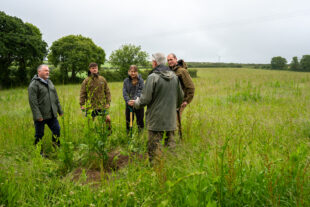https://defrafarming.blog.gov.uk/increase-soil-organic-matter/
Increase soil organic matter
The guidance on this page is for SFI pilot participants only. Please visit GOV.UK for the official Sustainable Farming Incentive scheme guidance.
Find out how land managers can improve soil structure, crop productivity and water quality by increasing soil organic matter.
If you’re completing this action as part of the Sustainable Farming Incentive pilot, how you do it is up to you.
The advice on this page can help you get better environmental and business benefits, but you do not have to follow it to get paid.
Why soil organic matter is important
Soils are a mix of:
- mineral material (sand, silt and clay) – their ratio determines soil texture
- air
- water
- organic matter
Organic matter is a small but vital part of soil. It’s made up of:
- living organisms, such as bacteria, fungi, plant roots and tiny animals
- decomposing plant or animal tissue
Organic matter is important for better soil fertility and structure, and overall soil health. To increase organic matter levels you can:
- add organic materials like solid or liquid manures, plants or crop residues
- reduce drainage or cultivation of soil to slow the decay of organic matter
You must follow the farming rules for water. These require you to take steps to stop manure, fertiliser or soil getting into water bodies.
Where to increase soil organic matter
Organic matter inputs will be most effective when added to poorly performing soils. This can include soils with:
- poor or uneven crop or grass growth
- crop diseases or problem weeds
- rapid surface waterlogging in winter
- drought problems in summer
Soils where past organic matter inputs have been low are the most likely to be in poor health. You should prioritise organic matter inputs on land where:
- you cultivate regularly
- root crops are part of the rotation
- crop residues are not returned to the soil
- cover crops and grass are not part of the rotation
The benefits of soil organic matter
Soil with more organic matter can absorb and keep in more water. This can improve crop productivity and reduce:
- tillage and irrigation costs
- flooding, as water moves more slowly through the landscape after heavy rain
- erosion and runoff
- greenhouse gas emissions
- fertiliser need, as nutrients are recycled more efficiently
- pesticide use, as more organic matter will reduce pests and disease
Soils with lower organic matter are at higher risk of wind erosion, especially sandy soils. Increasing organic matter will bind topsoil to help prevent wind blow and associated pollution from airborne particles.
Before you start increasing soil organic matter
Use a runoff and soil erosion risk assessment to check and record any:
- fields with eroded soil or running channels of water
- wind erosion - look for buried seedlings and soil blown into hedges or ditches, or onto nearby roads
Soil pits are a quick in-field way to check your soil for:
- shallow rooting depth
- slow water infiltration
- low earthworm numbers
- poor or weak soil structure
Read a guide to visually checking soil.
How to measure soil organic matter levels
Take soil samples and send them to a lab for analysis. Compare the results with your soil pit findings and soil mapping data.
For accurate results:
- Sample areas with roughly the same soil type and history.
- Where fields include multiple soil types, sample each separately.
- Collect 25 individual soil cores, in a clean plastic bag, to form one bulk sample of about 0.5kg.
- Take the cores in a ‘W’ pattern, with 5 to 7 cores along each leg of the ‘W’.
- Avoid irregular field areas, like manure heaps, pylons, gateways, headlands and around trees.
- Sample at the same time every year but do not sample if the soil is waterlogged or very dry.
- Do not sample within 3 months of manure or slurry application, as this will affect organic matter levels.
Take grassland cores to 7.5cm depth and arable cores to 15cm. A plough layer is typically 23cm deep, but if the soil in this layer is mixed a 15cm sample will be representative.
If you’re using min-till or no-till farming, nutrients can accumulate near the soil surface. A 15cm sample may give overly high readings, so sample to about 23cm. Read a guide to sampling different crops.
Your lab results should also include soil texture. Clay content influences how much organic matter a soil can normally store. Use your results to identify fields with below average soil organic matter.
How to add organic matter to soil
You can:
- use crop residues - chop and leave straw and not just crop roots or stubbles
- grow a cover crop or use green manures to feed the soil
- sow a mixed cover of deep-rooting grasses and herbs, which is particularly effective in compacted soil
- have a grass crop within an arable rotation for fields with low organic matter
If your soil is slow to warm in spring and delays germination, sow later. The overall crop benefits from higher organic matter levels should balance this out.
Add organic matter to the soil from:
- animal manures and slurries, either from your own farm or brought in from elsewhere
- digestates (material left after anaerobic digestion of biodegradable materials, like domestic food waste)
- manures or purpose-grown crops
- composts and biosolids
- paper crumble and wood
- abattoir and food processing by-products
Check if you can get funding for new precision manure application equipment.
You can allow soil organisms to mix in added organic matter, instead of using machinery. Only use this natural process where:
- soil condition is good
- runoff risk is low
- earthworms are abundant
Using the lab results, add to areas low in organic matter. You must follow best practice to use sewage sludge on your land. You may also need a landspreading permit.
Record organic matter inputs with a nutrient management plan. This will help you:
- avoid wasting money through excess fertiliser use
- optimise crop yields
- minimise nutrient pollution to water and air
Use cover crops or green manures and catch crops on land at high risk of pollution, instead of slurry or manures.
Use vegetation cover and low-emission spreading equipment, like a trailing hose or shoe, to prevent soil crusts that form when slurry is applied to bare soil. Low-emission spreading equipment will limit ammonia loss and make sure more nutrients reach the soil.
How to reduce soil organic matter loss
You can:
- add tougher organic matter with a high carbon-to-nitrogen ratio like straw, paper crumble, sawdust or wood chips
- switch to min-till or no-till farming, to disturb soil less
- reduce soil compaction from livestock and machinery
- manually disrupt tramlines to reduce soil erosion and runoff
- maintain vegetation cover to insulate soil against seasonal and daily warming
You could convert naturally wet arable ground to:
- permanent grassland
- rush pasture or fen
Pest control
More soil moisture and surface material can increase slugs, as well as beneficial pest predators. Find out how to control slugs.
How to tell if soil organic matter is increasing
Dig 20cm deep soil pits and look for darker coloured topsoil. As organic matter increases it will become similar in colour to uncultivated topsoil, like nearby hedge banks.
There will be more earthworms in the soil. Read a factsheet on how to count earthworms.
You’ll also see:
- deeper root penetration, especially by finer roots
- visible pores or spaces in most of the soil blocks or aggregates
- a looser, more crumb-like soil consistency without a visible compaction layer
You will:
- notice less surface water runoff and soil lost from your fields during heavy rain
- be able to work and use machinery on your land for longer periods without damaging the soil
- use less water abstracted from natural sources to irrigate during extended dry periods
- record higher than average organic matter levels for your soil type and level of clay



